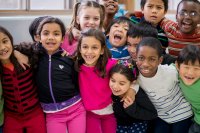Building a Supportive Classroom Community in Early Childhood
Preventing bullying in the early grades starts with fostering an environment that is safe for all students.
Your content has been saved!
Go to My Saved Content.As an educator and researcher who specializes in early childhood and also works with older grade levels, I’ve used National Bullying Prevention Month to reflect on ways bullying progresses as children age. I’ve been wondering what can be done in early childhood to prevent bullying in later grades.
I’ve reviewed the literature on bullying, including sites that provide suggestions on how to prevent and address bullying, but figuring out how to get started can be overwhelming as it involves deciphering what approaches align with who I am as an educator and researcher, and what principles I can incorporate in my work with young children. I’ve found it easier to focus on key concepts that I believe apply in all work with children.
One of those concepts is a strategy presented by StopBullying.gov for making the classroom a safe environment. Building a classroom community that is supportive of all learners and their families aligns well with a focus on early childhood. In my master’s and doctoral work, I’ve found that early childhood education often emphasizes the importance of building a classroom community that supports educators, children, and families.
What does creating a safe early childhood environment mean? How does one go about creating one? A combination of findings from research conducted in preschool classrooms and my experience with young children provides some guidance on how to start building a supportive and safe environment with young children.
3 Tips for Creating a Safe Classroom With Young Children
1. It’s OK that children notice difference—embrace it as a part of the community. Researchers and educators have pointed out that children notice physical differences starting in early childhood. Rather than overlooking this aspect of children’s growth, we can work to include these observations in the learning community.
For example, educators can use stories to celebrate the Three Ds—diversity, difference, and human dignity—and to highlight the inner qualities of the characters. Teachers can select stories based on children’s daily dialogue and experiences or on topics that will help in creating a safe environment. It’s important to select books and other types of media that can generate dialogue that’s relevant and meaningful to your learners.
Resources like Teaching for Change, Kids Like Us, and We Need Diverse Books are good places to start looking for books to use with young children.
2. Children may need time and support in resolving conflicts. For some children, early childhood education settings are the first place where they spend much time with others of their own age group, with young people outside of their family, or with kids who don’t reflect their family’s culture.
Therefore, the manner of interacting with peers won’t be the same for every child. For instance, some children may feel comfortable expressing their feelings through teasing, or may choose to communicate their reactions to their peers that way. Others may have learned that preserving the harmony of the group is important, making them hesitant to say anything if an interaction affects them negatively.
So it can be helpful to learn from our students’ families about their culture and how they resolve conflicting ideas and actions, as this can help us understand the reasons children interact with others in specific ways. Teachers can initiate this through a combination of talking with parents during drop-off and pickup, establishing monthly events that encourage family involvement, and inviting families to volunteer and participate in classroom activities.
Additionally, cultivating a pedagogy of listening in the classroom and modeling this with children and other adults can provide children another strategy for interacting with peers. Listening can create space for engagement and meaningful dialogue to work through disagreements and conflicts with their peers.
3. Community check-ins can be integrated throughout the school year. In early childhood, the classroom community usually extends to include the children’s families. We can work to establish guidelines that demonstrate that educators, children, and families are all important in creating a cohesive community. Anti-bias educators who work with young children emphasize negotiating the values, ideas, and approaches of the teacher, families, and children in order to build a learning community that is authentic and relevant to the classroom.
The community guidelines may evolve over time, so dialoguing with children and families about the guidelines throughout the school year is important and is reflective of the classroom community itself.
Building a safe early childhood community takes time. If you implement these recommendations, you may find that you need to make some adjustments for your classroom community. Understanding who you are as an educator, your perspective, and your biases can help with learning what you can do to create a safe space.
For me, sharing ideas and practices with a community of early childhood educators and researchers has been essential. By acknowledging the impact I have as an educator and researcher in preventing bullying, I’m able to cultivate better learning communities that support young children.
